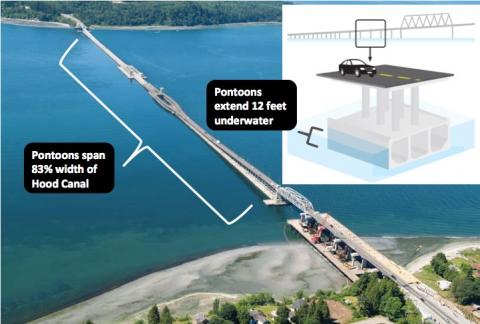SSM Water Quality: Hood Canal Bridge

Environmental Impact Assessment: Hydrodynamic and Water Quality Modeling, Washington
PNNL is part of a multi-party effort to assess the impacts of the Hood Canal Bridge - the world's third-longest floating bridge, which connects the Olympic and Kitsap peninsulas in western Washington. Earlier research by PNNL and others helped kick-start the project. The effort, lasting three and a half years and costing $4 million, will examine how the bridge is affecting salmon and the canal's ecosystem. A coalition of federal, state, tribal and nonprofit partners are leading the project.
The Environmental Impact Assessment will address the following questions:
- How is the bridge acting as a barrier to juvenile steelhead migration and leading to increased mortality? How does the bridge influence other fish, including salmon?
- Is the bridge impacting the entire Hood Canal ecosystem?

This project has its roots in 2013, when PNNL and NOAA published research that suggested the bridge could harm the Hood Canal ecosystem. Hood Canal is a classic fjord with a freshwater source (Skokomish River) at its head and a sill near the mouth. Circulation in typical fjords is characterized by a shallow brackish layer at the surface over a deep long and narrow saltwater column. This surface layer is responsible for the outflow of water from the fjord and is important for flushing of the basin and water quality maintenance. The vertical structure of circulation and transport is known to be easily disrupted. The researchers postulated that the stability of fjordal circulation may be vulnerable to impacts from anthropogenic alterations, such as floating structures, which could constrict the mixing and transport in the upper layers of the water column.
As part of this EIA, PNNL is leading the assessment of impacts on circulation and water quality through the following tasks:
- Measurements of noise impacts to fish behavior at the Hood Canal Bridge
- Design of nearfield hydrodynamic data collection
- Characterization of the bridge zone of influence - Hydrodynamic Modeling
- Modeling the effect of flushing, biogeochemistry, dissolved oxygen, and pH on the Hood Canal
Project Highlights
[Based on results presented in Khangaonkar and Wang (2013) to be updated in 2018 following the completion tasks listed above]
- The results indicate that although the bridge occupies only a small fraction of the cross section, its presence produces a local zero-velocity surface boundary condition that dampens the current magnitudes especially in the upper water column and slows down the fjordal water renewal process.
- The effect of the 4.57-m draft bridge on the Hood Canal results in in 8-13% longer residence times.
Contacts and Project Team
- PNNL: Tarang Khangaonkar, Daniel Deng, Taiping Wang, Wen Long, Adi Nugraha, Wenwei Xu
Study Reports and Publications
Khangaonkar, T and T Wang. 2013. Potential alteration of fjordal circulation due to a large floating structure - Numerical investigation with application to Hood Canal basin in Puget Sound. Applied Ocean Research, 39:146-157. doi: 10.1016/j.apor.2012.11.003